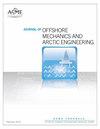波浪边界层作用下近底管道的水动力
IF 2.1
4区 工程技术
Q3 ENGINEERING, MECHANICAL
Journal of Offshore Mechanics and Arctic Engineering-Transactions of the Asme
Pub Date : 2023-06-11
DOI:10.1115/1.4062896
引用次数: 0
摘要
放置在海床附近的小直径海底管道和电缆上的水动力对于其海底稳定性设计非常重要。在海上环境中,这些管道通常会受到极端波浪条件的影响。本研究调查了波浪引起的边界层流动作用在平坦海床附近管道上的水动力。波浪引起的边界层流的Keulegan-Capenter数(KC)分别为20、140和200,其定义基于管道直径(D)、未扰动近床轨道速度的最大速度(Uw)和进入振荡流的周期(Tw)。基于Uw和D,雷诺数为1×104。海底粗糙度比ks/D(ks为Nikuradse等效沙粗糙度)高达0.1,管道与海底之间的不同间隙比G/D=0.05~0.5被考虑在内。基于二维(2D)非定常雷诺平均Navier-Stokes(URNS)方程和k-ω剪切应力输运(SST)湍流模型进行了数值模拟。进行了初步的一维(1D)模拟,以获得完全发展的波浪诱导边界层速度剖面,该剖面用作2D模拟的入口流。数值模型根据Sumer等人(1991)在KC=10时报告的实验数据进行了验证。详细讨论了KC、ks/D和G/D对水动力和周围流动的影响。本文章由计算机程序翻译,如有差异,请以英文原文为准。
Hydrodynamic Forces on a Near-bottom Pipeline Subject to Wave-induced Boundary Layer
Hydrodynamic forces on small diameter subsea pipelines and cables placed near seabed are important for their on-bottom stability design. In offshore environments, these pipelines are usually subjected to extreme wave conditions. The present study investigates hydrodynamic forces acting on a pipeline near a flat seabed subjected to a wave-induced boundary layer flow. The Keulegan-Carpenter numbers (KC) of the wave-induced boundary layer flow are 20, 140 and 200, defined based on the pipeline diameter (D), the maximum velocity of the undisturbed near-bed orbital velocity (Uw) and the period of the incoming oscillatory flow (Tw). Reynolds number is 1 × 104 based on Uw and D. A seabed roughness ratio ks/D (ks is the Nikuradse equivalent sand roughness) of up to 0.1 and different gap ratios of G/D = 0.05~0.5 between the pipeline and the seabed are considered. Numerical simulations have been carried out based on two-dimensional (2D) Unsteady Reynolds-Averaged Navier-Stokes (URANS) equations combined with the k-ω Shear Stress Transport (SST) turbulence model. A preliminary one-dimensional (1D) simulation is carried out to obtain a fully developed wave-induced boundary layer velocity profile, which is used as inlet flow for the 2D simulations. The numerical model is validated against the experimental data reported by Sumer et al. (1991) at KC = 10. Influences of KC, ks/D and G/D on the hydrodynamic forces and the surrounding flows are discussed in detail.
求助全文
通过发布文献求助,成功后即可免费获取论文全文。
去求助
来源期刊
CiteScore
4.20
自引率
6.20%
发文量
63
审稿时长
6-12 weeks
期刊介绍:
The Journal of Offshore Mechanics and Arctic Engineering is an international resource for original peer-reviewed research that advances the state of knowledge on all aspects of analysis, design, and technology development in ocean, offshore, arctic, and related fields. Its main goals are to provide a forum for timely and in-depth exchanges of scientific and technical information among researchers and engineers. It emphasizes fundamental research and development studies as well as review articles that offer either retrospective perspectives on well-established topics or exposures to innovative or novel developments. Case histories are not encouraged. The journal also documents significant developments in related fields and major accomplishments of renowned scientists by programming themed issues to record such events.
Scope: Offshore Mechanics, Drilling Technology, Fixed and Floating Production Systems; Ocean Engineering, Hydrodynamics, and Ship Motions; Ocean Climate Statistics, Storms, Extremes, and Hurricanes; Structural Mechanics; Safety, Reliability, Risk Assessment, and Uncertainty Quantification; Riser Mechanics, Cable and Mooring Dynamics, Pipeline and Subsea Technology; Materials Engineering, Fatigue, Fracture, Welding Technology, Non-destructive Testing, Inspection Technologies, Corrosion Protection and Control; Fluid-structure Interaction, Computational Fluid Dynamics, Flow and Vortex-Induced Vibrations; Marine and Offshore Geotechnics, Soil Mechanics, Soil-pipeline Interaction; Ocean Renewable Energy; Ocean Space Utilization and Aquaculture Engineering; Petroleum Technology; Polar and Arctic Science and Technology, Ice Mechanics, Arctic Drilling and Exploration, Arctic Structures, Ice-structure and Ship Interaction, Permafrost Engineering, Arctic and Thermal Design.

 求助内容:
求助内容: 应助结果提醒方式:
应助结果提醒方式:


